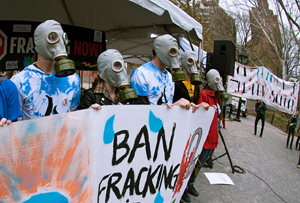sierraclub.org - sierra magazine - sept/oct 2011 - grapple: watershed moment
Watershed Moment | The Fire Next Time | Blue Period | As the World Warms | Woe is Us |
Bare New World | Up to Speed
WATERSHED MOMENT
Four states, one water source, and a dozen opinions on fracking
 Students from New York University and other schools rally in April in New York City in favor of a ban on fracking. | Richard B. Levine
Students from New York University and other schools rally in April in New York City in favor of a ban on fracking. | Richard B. Levine
Snaking across four states, the Delaware River is the mid-Atlantic's largest source of surface drinking water, serving 15 million people. But a third of the river's basin sits atop the Marcellus Shale, a sedimentary-rock formation that contains some 500 trillion cubic feet of natural gas.
Once considered unobtainable, shale gas can now be liberated through hydraulic fracturing, or "fracking," in which large amounts of water are mixed with sand and chemicals and pumped into rock to force bubbles of natural gas in-to wells. Even though fracking generally occurs far below aquifers, those chemicals—along with naturally occurring compounds like methane and radium—have a way of leaking into drinking water; reports of radioactive, contaminated, or even flammable water are increasing. Conveniently for the natural gas industry, however, Congress exempted fracking from the Safe Drinking Water Act in 2005.
Energy companies could drill as many as 18,000 wells in the upper part of the watershed, but all applications are on hold while the Delaware River Basin Commission—composed of the region's four governors and one federal representative—issues regulations. The commission is divided: Pennsylvania generally gives energy companies free rein, New York recently lifted a fracking moratorium, New Jersey has banned the practice, and Delaware is waffling.
The Obama administration remains solidly pro-fracking. EPA administrator Lisa Jackson says that she is "not aware of any proven case where the fracking process itself" has contaminated water supplies. But last February a New York Times investigation found Pennsylvania sewage-treatment plants incapable of removing toxic fracking chemicals from the million gallons of wastewater produced by each well. The partially treated wastewater ends up back in area rivers—or coming out of faucets. In April, a blowout at a well in Leroy Township, Pennsylvania, sent thousands of gallons of fracking fluids into a tributary of the Susquehanna River, the drinking-water source for more than 6 million people.
"We have an ever-increasing number of accidents and spills and catastrophic events across Pennsylvania that are waking people up," says Maya van Rossum, who leads the Delaware Riverkeeper Network. But will they wake up the Obama administration and the Delaware River Basin Commission? —Dashka Slater
The Fire Next Time